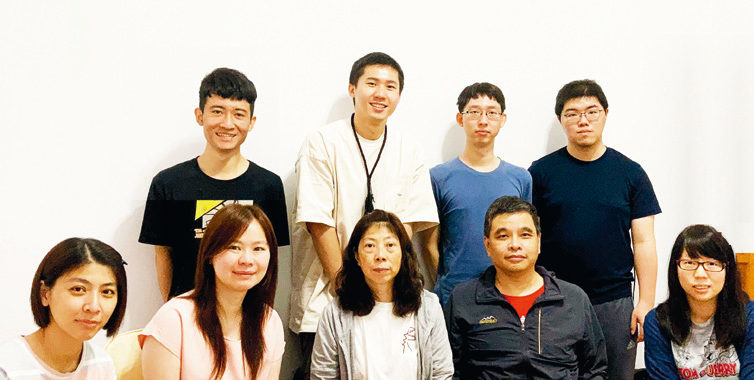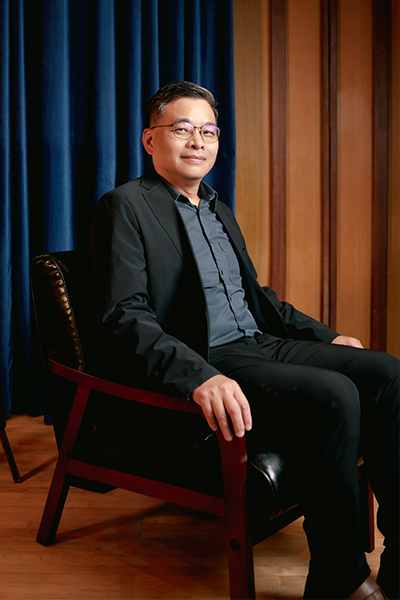減數分裂遺傳重組與重複誘發點突變的分子機制
減數分裂是孟德爾遺傳學的核心。減數分裂是真核生物有性生殖細胞專有的細胞分裂方式,會使得染色體數目減半,製造出單倍體的精子、卵或真菌有性孢子。 我們實驗室以麵包酵母菌與工業用瑞氏木黴菌為模式,利用遺傳學、分子生物學、生物化學、結構生物學、基因體學與生物資訊學等方法,探討減數分裂細胞中 DNA 修補、同源重組與 DNA 損傷反應如何產生遺傳變異與維持基因體完整性。
重複誘發點突變(repeat-induced point mutation)是表觀遺傳學(epigenetics)的典範。重複誘發點突變是許多絲狀子囊菌(如工業用瑞氏木黴菌)有性生殖細胞特有的基因體防禦機制,利用兩個甲基化轉移酵素家族基因 dim2 與 rid1,將重複 DNA 序列與跳躍基因去活或滅能。
我們最近的研究可分為四大項:
- 大多數進行有性生殖的真核生物(如酵母菌、擔子菌、果蠅、線蟲、高等植物與哺乳類)的減數分裂細胞,利用 Spo11 蛋白產生 DNA 雙股斷裂,從而啟動遺傳重組反應。我們發現剔除 spo11 基因的木黴菌仍能正常進行減數分裂與產生有性孢子。 目前研究重點在探討木黴菌如何啟動減數分裂遺傳重組反應。
- 麵包酵母菌或人類均以Rad51 與Dmc1 兩個同源重組酵素催化減數分裂遺傳重組,木黴菌只有Rad51 無Dmc1。我們致力於比較分析麵包酵母菌Rad51、麵包酵母菌Dmc1 與木黴菌Rad51 的功能異同處。
- DNA 損傷反應調控減數分裂遺傳重組、同源染色體聯會(synapsis)與染色體動態變化的分子機制。
- 木黴菌的dim2 與rid1 將重複DNA 序列的胞嘧啶(C)先甲基化,再點突變成胸腺嘧啶(T)的化學機制。
- PDF, 1999-2000, Dept. Mol. & Cell Biol., Harvard Univ. USA
- Ph.D., 1998, Dept. Mol. & Cell Biol., Harvard Univ. USA
- MS, 1990, Inst. Life Science., Natl. Tsing Hua Univ.
- BS, 1988, Dept. Chemistry, Natl. Taiwan Univ.
- Chen, C.L, Li, W.C., Chuang, Y.C., Liu, H.C., Huang, C.H., Lo, K.Y., Chen, C.Y., Chang, F.M., Chang, G. A., Lin, Y.L., Yang, W.D., Su, C.H., Yeh, T.M. and *Wang T.-F. (2022) Sexual crossing, chromosome-level genome sequences, and comparative genomic analyses for the medicinal mushroom Taiwanofungus camphoratus (Syn. Antrodia cinnamomea, Antrodia camphorata). Microbiology Spectrum 10, e02032-21. PMID:35196909
- Li, W.C., Lin, T.C., Chen, C.C., Liu, H.C., Lin, H.N., Chao, J.L., Hsieh, C.H., Ni, H.F., Ruey- Chen, R.S.* and *Wang T.-F. (2021) Complete genome sequences and genome-wide characterization of Trichoderma biocontrol agents provide new insights into their evolution and variation in genome organization, sexual development, and fungal-plant interactions. Microbiology Spectrum 9, e00663-21. PMID:34908505.
- Li, W.-C. #, Lee C.-Y. #, Lan, W.-H. #, Woo, T.-T. #, Liu, H.-C., Yeh, H.-Y., Chang, H.-Y., Chuang, Y.-C., Chen, C.-Y., Chuang, C.-N., Chen, C.-L., Hsueh, Y.-P., Li, *W.-H., P, *Chi., and *Wang T.-F. (2021) Trichoderma reesei Rad51 tolerates mismatches in hybrid meiosis with diverse genome sequences. Proc. Natl. Acad. Sci. USA 118. PMID: 33593897.
- Liu, H.-C. #, #Li, W.-C.#, and *Wang, T.-F.* (2020) TSETA: a third-generation-sequencing based program for single-nucleotide-resolution mapping of meiotic recombination products and repeat-induced point mutations. Methods in Molecular Biology 2234: 331-361. PMID: 3316579.
- Woo, T.T., Chuang, C.N., Higashide, M., Shinohara, A., *Wang, T.F. (2020) Dual roles of yeast Rad51 N-terminal domain in repairing DNA double-strand breaks. Nucleic Acids Research 48, 8474-8489 PMID:32652040.
- Li, W.-C., Huang, C.-H., Chen, C.-L., Chuang, Y.-C., Tung, S.-Y. and *Wang T.-F. (2017) Trichoderma reesei complete genome sequence, repeat-induced point mutation and partitioning of CAZyme gene clusters. Biotechnology for Biofuels 10:170 PMID:28690679
- Chen, Y.-J., Chuang, Y.-C., Chuang, C.-N., Cheng, Y.-H., Chang, C.-R., *Leng, C.-H. and *Wang, T.-F. (2016) Mre11 recruits conjugated SUMO moieties to facilitate the assembly and function of the Mre11-Rad50-Xrs2 complex. Nucleic Acids Research 44, 2199-2213. PMID:2.6743002
- Cheng, Y.-H., Chuang, C.-N., Shen, H.-J., Lin, F.-M. and *Wang, T.-F. (2013) Three different modes of Mec1/ATR and Tel1/ATM activation in budding yeast early meiosis. Molecular and Cellular Biology 33, 3365-3376. PMID: 23775120.
- Chuang, C.-N., Cheng, Y.-H. and *Wang, T.-F. (2012) Mek1 stabilizes Hop1-Thr318 phosphorylation to promote interhomolog recombination and checkpoint responses during yeast meiosis. Nucleic Acids Research 40, 11416-11427. PMID:23047948.
- Lai, Y.-J., Lin, F.-M., Chuang, M.-J., Shen, H.-J. and *Wang, T.-F. (2011) Genetic requirements and functions of phosphorylation of the yeast axial element protein Red1. Molecular and Cell Biology 31, 912-923
- Lin, F.-M., Lai, Y.-J., Shen, H.-J., Cheng, Y.-H. and *Wang, T.-F. (2010) Yeast axial element protein Red1 binds SUMO chains to promote meiotic interhomolog recombination and chromosome synapsis. EMBO Journal 29, 586-596. PMID:19959993
- Chen, L.-T., Ko, T.-P., Chang, Y.-C., Lin, K.-A., Chang, C.-S., *Wang, A. H.-J. and *Wang, T.-F. (2007) Crystal structure of the left-handed Archaeal RadA helical filament: Identification of a new functional motif for controlling quaternary structures and enzymatic activity of RecA family proteins. Nucleic Acids Research 35, 1781-1801. PMID:17329376.
- Cheng, C.-H., Lo, Y.-H., Liang, S.-S., Ti, S.-C., Lin, F.-M., Yeh, C.-H., Huang, H.-Y. and *Wang, T.-F. (2006) SUMO modifications control assembly of synaptonemal complex and polycomplex in meiosis of Saccharomyces cerevisiae. Genes & Development 20, 1986-1992. PMID: 16847351.
- Chen, Y.-K., Leng, C.-H., Olivares, H., Lee, M.-H., Chang, Y.-C., Kung, W.-M., Ti., S.-C., Lo, Y.-H., Wang., A. H.-J., Chang, C.-S., Bishop, D. K., Hsueh, Y.-P. and *Wang, T.-F. (2004) Heterodimeric complexes of meiosis-specific Hop2 and Mnd1 promote DNA recombination and homolog juxtaposition. Proc. Natl. Acad. Sci. USA 101, 10572-10577. PMID: 15249670.
- Wang, T.-F., Chin-Ning Chuang and Tai-Ting Woo. “Method and vector for enhancing protein expression”. US provisional application (63/036,704), Patent Cooperation Treaty application (PCT/US2021/036247) and Taiwan application (110120541).
- Wang, T.-F., “Method for producing segmental aneuploidy (SAN) strains of Trichoderma reesei via sexual crossing and SAN strains produced therefrom”. Patent Cooperation Treaty (PCT/US14/58654) and US (9598738B2), Taiwan (I570236) and People’s Republic of China (IA001/ACA081CN).
- Wang, T. F. and Yang, S.M. “Methods of producing virus-like particles of piconavirus using a small-ubiquitin-related fusion protein expression system”. US (8663951B2) and Taiwan (I415623).
- Wang, T.-F. “SUMO fusion protein expression system for producing native proteins”. USA 8034910BZ.


